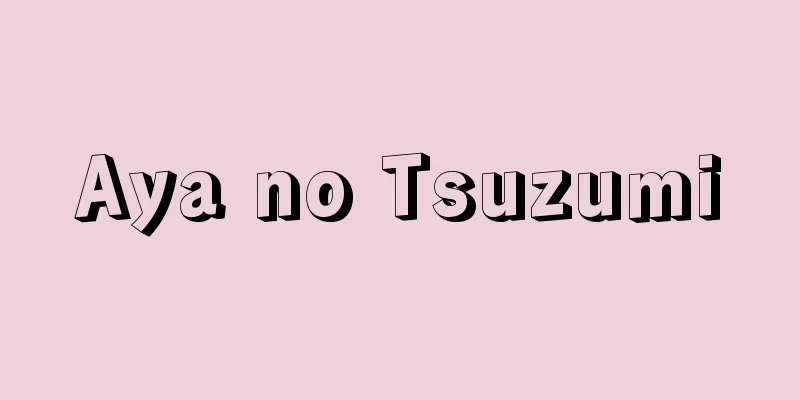Aya no Tsuzumi

|
Noh piece. The fourth piece. Current version of the Hosho and Kongo schools. The Kita school version was reworked by Toki Zenmaro and restored in 1952 (Showa 27). It is based on the ancient work "Aya no Taiko" mentioned in Zeami's writings. It has a bold setting of love between old people, and between people of completely different social status. Compared to "Koino Omotoni," a work on the same theme written by Zeami, "Aya no Taiko" is permeated with the roughness of ancient passion. A servant (waki) appears and explains that an old man sweeping the garden (mae shite) is in love with the Empress (tsure), and summons the old man to give him a test. The Empress has a message that if the sound of the drum is heard in the Imperial Palace, her wish will come true. Not realizing that the drum is made of twill, which should never sound, the old man tries in his last hope, but in despair, he throws himself into the pond and dies. A curse is placed on the Empress. The evil spirit of the old man (Go-Shite), with disheveled white hair, tortures her, and then sinks into the pond again, filled with resentment. Toki Zenmaro's adaptation shows modern interpretations and treatments. Mishima Yukio adapted this Noh play into a modern drama in his "Modern Noh Plays," and in 1956 (Showa 31), Takechi Tetsuji directed it, achieving brilliant results with a collaboration between Noh and Kyogen actors and new theater actors. [Masuda Shozo] [Reference] |Source: Shogakukan Encyclopedia Nipponica About Encyclopedia Nipponica Information | Legend |
|
能の曲目。四番目物。宝生(ほうしょう)、金剛(こんごう)流現行曲。喜多(きた)流は土岐善麿(ときぜんまろ)の改作で、1952年(昭和27)に復曲。世阿弥(ぜあみ)の伝書にいう古作『綾の太鼓』が原作。老いらくの、しかもまったく身分違いの恋という大胆な設定である。同じテーマを世阿弥が書いた『恋重荷(こいのおもに)』に比べると、『綾鼓』は古代的な情念の荒々しさに貫かれている。臣下の者(ワキ)が出て、庭掃きの老人(前シテ)が女御(にょご)(ツレ)に恋していることを述べ、老人を呼び出して試練を与える。鼓の音が皇居に聞こえたら思いをかなえようという女御の伝言である。鳴るはずのない綾で張った鼓とは知らず、一縷(いちる)の望みに老人は挑戦し、絶望し、池に身を投げて死ぬ。女御に呪(のろ)いがかかる。白髪を振り乱した老人の悪霊(後シテ)は、女御を責めさいなみ、恨みのまま、また池に沈んでいく。土岐善麿の改作には近代的な解釈と処理がみられる。三島由紀夫はその『近代能楽集』にこの能を現代劇に翻案し、1956年(昭和31)武智(たけち)鉄二演出により、能と狂言の役者、新劇俳優の共演でみごとな成果を収めた。 [増田正造] [参照項目] |出典 小学館 日本大百科全書(ニッポニカ)日本大百科全書(ニッポニカ)について 情報 | 凡例 |
Recommend
Pointe‐Noire (English spelling)
A port city facing the Atlantic Ocean in the south...
Tropotaxis
…The positive phototaxis of the photosynthetic pr...
Separate payment - Bechinou
〘Noun〙 ("Bechi" is the Go-on pronunciati...
Exchange interaction -
This is a spin-related interaction that occurs wh...
Amphioxus (Slugfish) - Branchiostoma belcherii
A protochordate of the family Amphioxus of the cla...
Yoshio Okamoto
Children's literature author. Born in Osaka. ...
upper protrusion
…This is an occlusion disorder in which the gap b...
ECE - Electrical and Computer Engineering
Economic Commission for Europe United Nations Econ...
Releaser - Releaser (English spelling)
In ethology, it is defined as "a certain sti...
Hochofen
…To make this heat transfer and reaction process ...
Hypericum
...A perennial plant of the Hypericaceae family t...
The wolf has come - The wolf has come
...Tom Tiddler's Territory, Prisoner's Ba...
Nilo‐Saharan
A group of African languages found in a wide are...
stēlē (English spelling) stele
…The tombs in the Mycenae citadel (c. 1500 BC) we...
Yue-zhou-yao (English name)
The oldest porcelain kilns in the Orient, develope...









